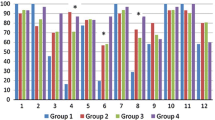Abstract
Purpose
This study aimed to compare the first-trimester pregnancy serum total oxidative status (TOS), total antioxidant status (TAS), and serum estradiol levels as well as the olfactory functions assessed using the brief smell identification test (BSIT) of women with healthy pregnancies and those with hyperemesis gravidarum (HG).
Methods
In this prospective study, 60 pregnant women in the first trimester of their pregnancies were divided into two groups: 30 pregnant women with HG (study group) and 30 healthy pregnant women (control group). The following parameters were compared in the HG group and the healthy controls: TOS, TAS, serum levels of estradiol (E2), and olfactory function, which was measured using BSIT.
Results
Both groups were similar in terms of age, gravida, and parity. The mean total smell score was lower in the HG group than the healthy control group (p < 0.05). TOS was significantly higher in the HG group than the control group. TAS was significantly higher in the control group than the HG group (p < 0.05).
Conclusion
The removal of sharp odors that will trigger the perception of odor in pregnant women with HG can contribute to the effective control of this disease; moreover, adding fetal-safe antioxidants to the treatment can contribute to the effective control of this disease.
Similar content being viewed by others
References
Jewel D, Young G (2003) Intervetions for nausea and vomiting in earlypregnancy. The cochrane library. John Wiley&Sons Ltd, Chichester, UK
Black FO (2002) Maternal susceptibility to nausea and vomiting of pregnancy: Isthe vestibular system involved? Am J Obstet Gynecol 186:204–209
Gadsby R, Barnie-Adshead AM, Jagger C (1993) A prospective study of nauseaand vomiting during pregnancy. Br J Gen Pract 43:245–248
Bailit JL (2005) Hyperemesis gravidarium: epidemiologic findings from a large cohort. Am J ObstetGynecol 193:811–814
Sandven I, Abdelnoor M, Nesheim BI, Melby KK (2009) Helicobacter pylori infection and hyperemesis gravidarum: a systematic review and meta-analysis of case-control studies. Acta Obstet Gynecol Scand 88:1190–1200
Katon WJ, Ries RK, Bokan JA, Kleinman A (1980) Hyperemesis gravidarum: a biopsychosocial perspective. Int J Psychiatry Med 10(2):151–162
Goodwin TM (2002) Nausea and vomiting of pregnancy: an obstetric syndrome. AmJ Obstet Gynecol 186(suppl):S184-189
Onaran Y, Kafali H, Duvan CI, Keskin E, Celik H, Erel O (2014) Relationship between oxidant and antioxidant activity in hyperemesis gravidarum. J Matern Fetal Neonatal Med 27(8):825–828
Fait V, Sela S, Ophir E, Khoury S, Nissimov J, Tkach M et al (2002) Hyperemesis gravidarum is associated with oxidative stress. Am J Perinatol 19:93–98
Moosman B, Behl C (2002) Secretory peptide hormones are biochemical antioxidants: structure–activity relationship. Mol Pharmacol 61:260–268
Cuffe JS, Xu ZC, Perkins AV (2017) Biomarkers of oxidative stress in pregnancy complications. Biomark Med 11(3):295–306
Simsek G, Bayar Muluk N, Arikan OK, Ozcan Dag Z, Simsek Y, Dag E (2015) Marked changes in olfactory perception during early pregnancy: a prospective case-control study. Eur Arch Otorhinolaryngol. 272(3):627–630
Erel O (2005) A new automated colorimetric method for measuring total oxidant status. Clin Biochem 38:1103–1111
Ege S, Bademkiran MH, Peker N, Erdem S, Bağli İ, Köçeroğlu R et al (2019) Evaluation of catalase, myeloperoxidase and ferroxidase values in pregnant women with hyperemesis gravidarum. Ginekol Pol 90(11):651–655
Ege S, Peker N, Bademkıran MH, Köçeroğlu R, Erel Ö, Erdem S et al (2020) The thiol/disulfide balance in ketone positive and ketone negative pregnant women with nausea and vomiting—a prospective study in a tertiary center. Ginekol Pol 91(4):207–209
Kleine I, Da Silva A, Ahmed W, Forya F, Whitten SM, David AL et al (2017) Hospital admission for hyperemesis gravidarum in women at increased risk of spontaneous preterm birth. Birth 44(4):384–389
Boelig RC, Barton SJ, Saccone G, Kelly AJ, Edwards SJ, Berghella V (2017) Interventions for treating hyperemesis gravidarum: a cochrane systematic review and meta-analysis. J Matern Fetal Neonatal Med. 11:1–14
Sugiura-Ogasawara M, Furukawara TA, Nakano Y, Hori S, Aoki K, Kitamura T (2002) Depression as a potential causal factor in subsequent miscarriage in recurrent spontaneous abortion. Hum Reprod 17:2580–2584
Nakano Y, Oshima M, Sugiura-Ogasawara M, Aoki K, Kitamura T, Furukawa TA (2004) Psychosocial predictors of successful delivery after unexplained recurrent spontaneous abortions: a cohort study. Acta Psychiatr Scand 109:440–446
Uguz F, Gezginc K, Kayhan F, Cicek E, Kantarci AH (2012) Is hyperemesis gravidarum associated with mood, anxiety and personality disorders: a casecontrol study. Gen Hosp Psychiatr 34:398–402
Yilmaz S, Ozgu-Erdinc AS, Demirtas C, Ozturk G, Erkaya S, Uygur D (2015) The oxidative stress index increases among patients with hyperemesis gravidarum but not in normal pregnancies. Redox Rep. 20(3):97–102
Sari N, Ede H, Engin-Ustun Y, Göçmen AY, Çağlayan EK (2017) Hyperemesis gravidarum is associated with increased maternal serum ischemia-modified albumin. J Perinat Med 45(4):421–425
Funding
This work was supported by the Kirikkale University Scientific Research Projects and Coordination Unit (project number 2014/078).
Author information
Authors and Affiliations
Contributions
YŞ: Planning, designing, data collection, literature survey, statistical analysis, writing. GŞ: Planning, designing, data collection, literature survey, statistical analysis, writing. NBM: Planning, designing, literature survey, writing, submission. OKA: Planning, designing, literature survey.
Corresponding author
Ethics declarations
Conflict of interest
All authors declare that they have no conflict of interest.
Ethics approval
Ethics committee approval was obtained from the Adana Training and Research Hospital Ethics Committee (Date: June 5, 2014 Number: 2014/19).
Consent to participate
The participants provided their signed informed consent.
Additional information
Publisher's Note
Springer Nature remains neutral with regard to jurisdictional claims in published maps and institutional affiliations.
Rights and permissions
About this article
Cite this article
Şimşek, Y., Şimşek, G., Bayar Muluk, N. et al. Olfactory dysfunction and oxidative stress in pregnant women with hyperemesis gravidarum. Arch Gynecol Obstet 304, 657–661 (2021). https://doi.org/10.1007/s00404-021-05998-9
Received:
Accepted:
Published:
Issue Date:
DOI: https://doi.org/10.1007/s00404-021-05998-9




